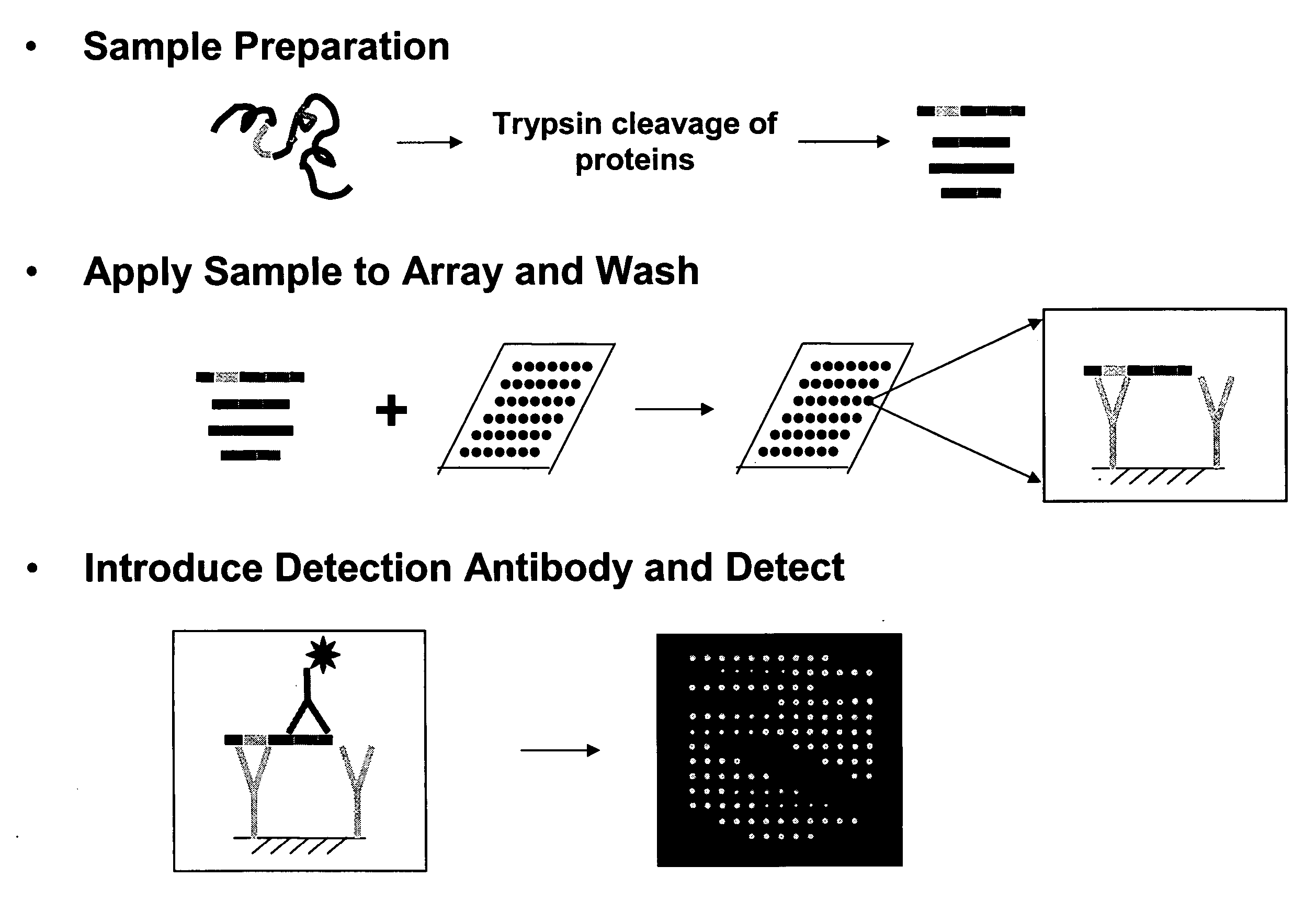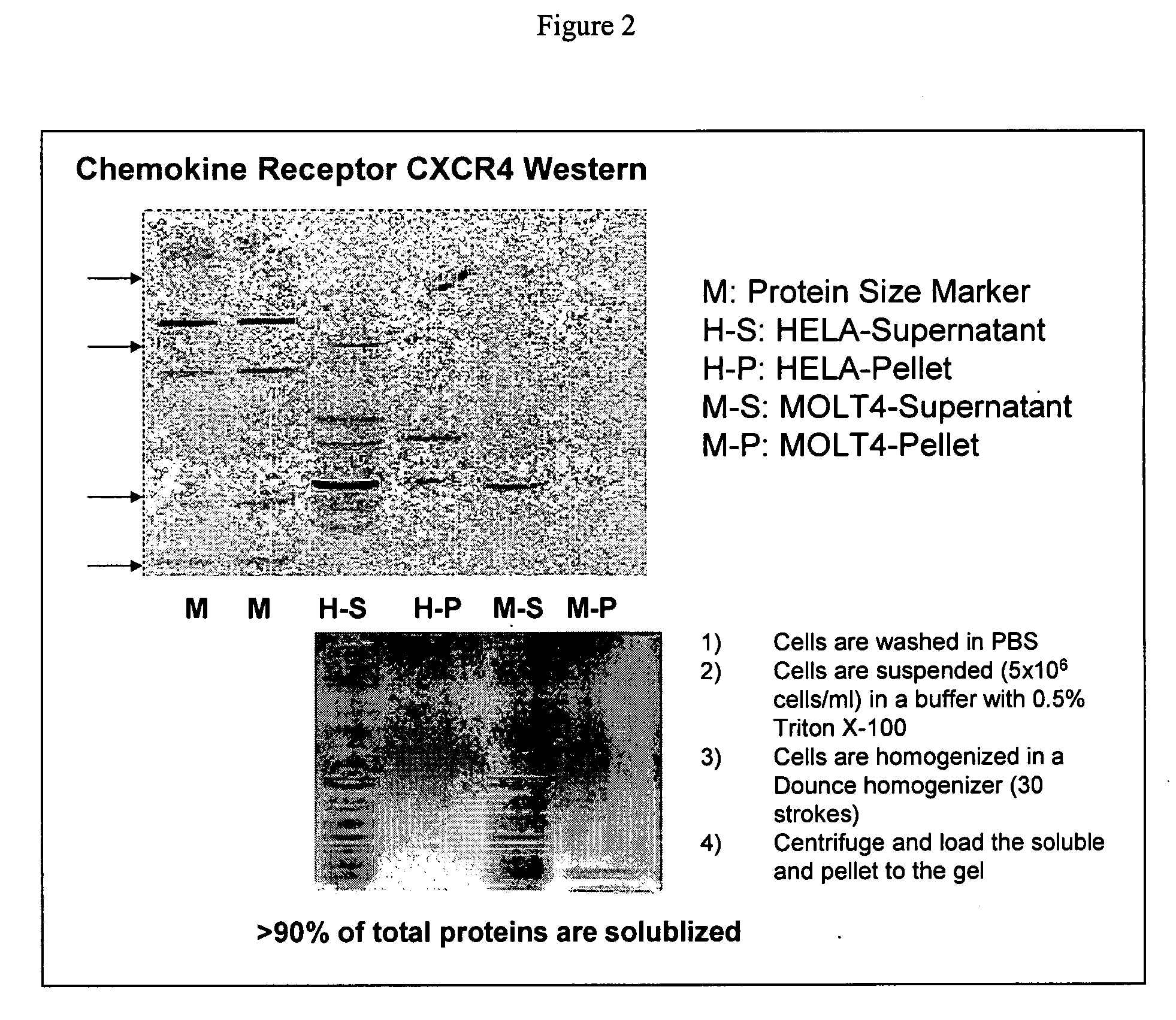Proteome epitope tags and methods of use thereof in protein modification analysis
a protein and epitope technology, applied in the field of proteome epitope tags and methods of protein modification analysis, can solve problems such as significant background issues, and achieve the effect of improving the clinical value of the psa test and improving the sensitivity/selectivity of the assay
- Summary
- Abstract
- Description
- Claims
- Application Information
AI Technical Summary
Benefits of technology
Problems solved by technology
Method used
Image
Examples
example 1
Detection and Quantitation in a Complex Mixture of a Single Peptide Sequence with Two Non-Overlapping Pet Sequences Using Sandwich Elisa Assay
[0432] A fluorescence sandwich immunoassay for specific capture and quantitation of a targeted peptide in a complex peptide mixture is illustrated herein.
[0433] In the example shown here, a peptide consisting of three commonly used affinity epitope sequences (the HA tag, the FLAG tag and the MYC tag) is mixed with a large excess of unrelated peptides from digested human protein samples (FIG. 9). The FLAG epitope in the middle of the target peptide is first captured here by the FLAG antibody, then the labeled antibody (either HA mAb or MYC mAb) is used to detect the second epitope. The final signal is detected by fluorescence readout from the secondary antibody. FIG. 9 shows that picomolar concentrations of HA-FLAG-MYC peptide was detected in the presence of a billion molar excess of digested unrelated proteins. The detection limit of this me...
example 2
[0442] In certain embodiments of the invention, a peptide competition assay may be used to determine the binding specificity of a capture agent towards its target PET, as compared to several nearest neighbor sequences of the PET.
[0443] For a typical peptide competition assay, the following illustrative protocol may be used: 1 μg / 100 μl / well of each target peptide is coated in Maxisorb Plates with coating buffer (carbonate buffer, pH 9.6) overnight at 4° C., or 1 hour at room temperature. The plates are washed with 300 μl of PBST (1×PBS / 0.05% tween 20) for 4 times. Then 300 μl of blocking buffer (2% BSA / PBST) is added and the plates are incubated for 1 hour at room temperature. Following blocking, the plates are washed with 300 μl of PBST for 4 times.
[0444] Synthesized competition peptides are dissolved in water to a final concentration of 2 mM solution. Serial dilution of competition peptides (for example, from 100 pM to 100 μM) in digested human serum ar...
example 3
Pet-Specific Antibodies are Highly Specific and have High Affinity for their Pet Antigens
[0447] There are numerous PET-specific antibodies that were shown to be highly specific and have high affinity for their respective antigens. The following table lists a few exemplary antibodies showing high affinity (low nanomolar to high picomolar range) for their respective antigens.
LengthAffinityPeptide Sequence(aa)(KD in nM)ReferenceGATPEDLNQKLAGN141.4Cell 91: 799, 1997CRGTGSYNRSSFESSSG172.8JIM 249: 253, 2001NYRAYATEPHAKKKS150.5EJB 267: 1819,2000RYDIEAKVTK103.5JI 169: 6992, 2002DRVYIHPF80.5JIM 254: 147, 2001PQSDPSVEPPLS1216 (a scFv)NG 21: 163, 2003YDVPDYAS (HA tag)82engeneOSMDYKAFDN (FLAG tag)82.3engeneOSHHHHH (HIS tag)525Novagen
[0448] Further more, the table below shows three additional PET-specific antibodies with similar nanomolar-range affinity for the respective antigens:
PET SequenceAb nameAffinity (KD in nM)Parental ProteinEPAELTDAP15PSAYEVQGEVFC131CRPGYSIFSYAC2200CRP
[0449] These...
PUM
| Property | Measurement | Unit |
|---|---|---|
| time | aaaaa | aaaaa |
| concentrations | aaaaa | aaaaa |
| concentration | aaaaa | aaaaa |
Abstract
Description
Claims
Application Information
 Login to View More
Login to View More - R&D
- Intellectual Property
- Life Sciences
- Materials
- Tech Scout
- Unparalleled Data Quality
- Higher Quality Content
- 60% Fewer Hallucinations
Browse by: Latest US Patents, China's latest patents, Technical Efficacy Thesaurus, Application Domain, Technology Topic, Popular Technical Reports.
© 2025 PatSnap. All rights reserved.Legal|Privacy policy|Modern Slavery Act Transparency Statement|Sitemap|About US| Contact US: help@patsnap.com



